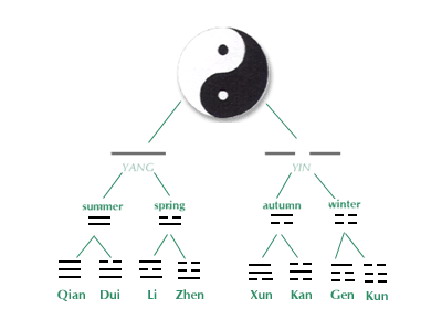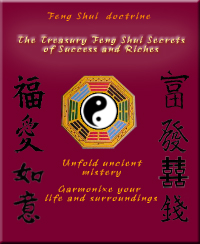A Trigram is a structure made up of three parallel lines. These individual lines might be Yin or Yang. Yang is a solid bar and Yin is a broken bar. The trigrams were originally formed to describe the evolution of things stemming from the duality of yin and yang. Trigrams were first attributed to Fu Hsi (Xi), the legendary Emperor of China (circa 3300 B.C.), and, as the story goes, the discovery was made from the markings on the back of a tortoise. From the drawings of those markings, he formed a document known as the Yellow River Map, and then developed a mathematical ordering of the trigrams.

The trigrams represent all the cosmic and physical conditions on earth. Their attributes are used in The Book of Change (I Ching) as follows:
Qian (Heaven - NW) firmness, creativity, strength, force, power
Dui (Lake - W) joy, openness, pleasure, satisfaction, excess
Li (Fire - S) Illuminating, clarity, intelligence, dependence, attachment
Zhen (Thunder - E) arousing, movement, activity, shock, growth
Xun (Wind - SE) gentle effects, small efforts
Kan (Water - N) mysterious, profound, meaningful, dangerous, difficult
Gen (Mountain - NE) still, resting, meditating, tranquil
Kun (Earth - SW) yielding, receptive, responsive, devoted
Trigrams were used prior to the hexagrams that are used in the I Ching for divination. Trigrams are also seen as family members in their archetypal roles: father/strong, mother/devoted, eldest/middle/youngest son and/or daughter. In addition, the trigrams are also expressed as the seasons, parts of the body, points of the compass, and so forth. Additionally, the trigrams hold the keys to understanding the who or what is affected by the Feng Shui of a building. This became a very useful almanac and oracle for those seeking to understand the nature and tendencies of change.
The Personal Trigram gives the element and trigram that a person belongs to it also describes the main characters of a person













